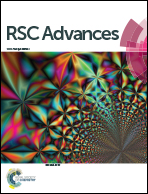Negative imaginary parts of complex permeability and microwave absorption performance of core double-shelled FeCo/C/Fe2.5Cr0.5Se4 nanocomposites†
Abstract
Cactus-shaped core double-shelled FeCo/C/Fe2.5Cr0.5Se4 nanostructures with a spiky surface were prepared by combining an arc-discharge process with a high-temperature solution chemical method, in which FeCo nanoparticles serve as the, while carbon and ferrimagnetic Fe2.5Cr0.5Se4 (FCS) are the inside and the outside shells, respectively. The magnetic properties, electromagnetic response, and microwave absorption properties of the (x)FeCo/C/FCS nanocomposites in the 1–18 GHz frequency range were investigated by changing the mass ratio x between FeCo/C and FCS. The frequency dependences of μ′′ (imaginary parts of complex permeability) and ε′′ (imaginary parts of complex permittivity) of the (0 ≤ x ≤ 0.15)FeCo/C/FCS nanocomposites show distinct inverse trends of change in the high frequency ranges. Negative minimum values of μ′′ are found to be coupled with positive maxima of ε′′ due to a phase lag. The bare FCS–paraffin composite starts with a minimum μ′′ of about −0.07, which shifts to −0.44 and −0.05 when the mass ratio x is increased to 0.1 and 0.15, respectively. As x increases to 0.2, all the μ′′ values of the nanocomposites become positive. The best absorption property with a reflection loss (RL) peak of −54.5 dB at 10 GHz is obtained in the (x = 0.1)FeCo/C/FCS–paraffin composite and RL exceeding −20 dB can be achieved within the 3–18 GHz frequency range by choosing an appropriate layer thickness between 1.4 and 6 mm. The contribution of the negative μ′′ response to the microwave absorption is discussed.


 Please wait while we load your content...
Please wait while we load your content...